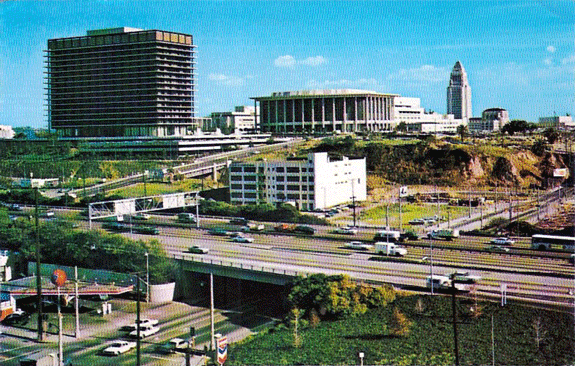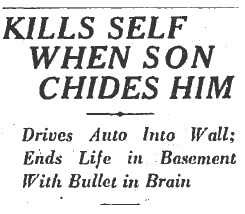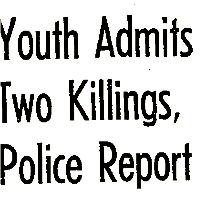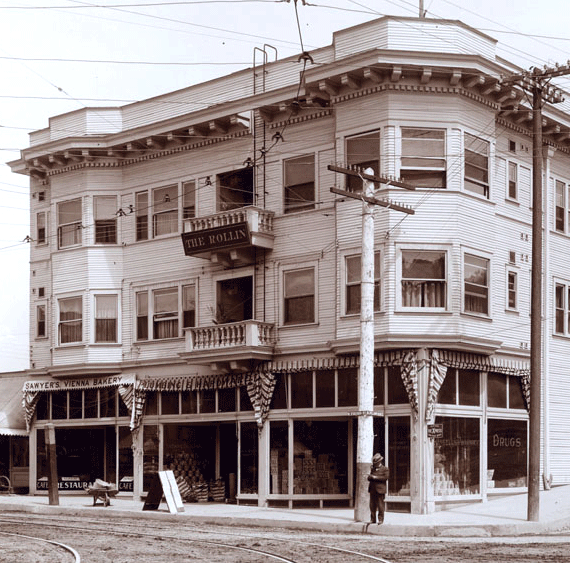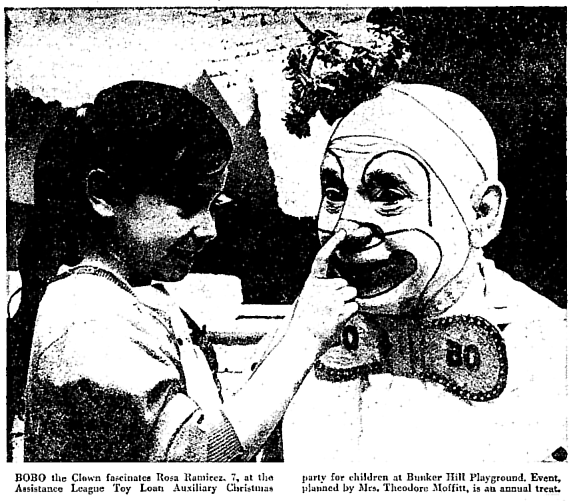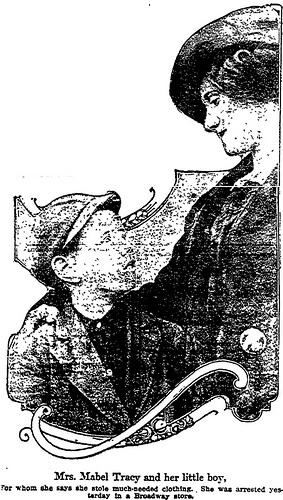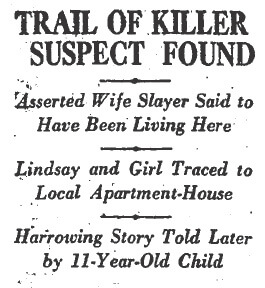An amazing discovery from the good folks at the Internet Archive. Visit the Off Bunker Hill list, where LA historians and former Bunker Hill residents have been identifying structures and dating vehicles. One person even thinks they’ve spotted their father leaning on a lampost!
Tag: 200 Block
The Many Faces of 123 South Figueroa
After the DWP and Dorothy Chandler went up, postcard photographers said whoopee! something to shoot besides City Hall and the Chinese. So they cruised up to the bluff on Huntley, trained their lenses across Second and Beaudry toward First and Flower and fired away. The day view is a Plastichrome by Colourpicture, the night view by Western Publishing & Novelty, both circa 1965.


Dig the Union station in all its 76 ball glory (the SoCal station with its backlit chevron seems to be of an earlier vintage; they‘re both gone now). Printers shops and giant spools line Beaudry. Were it not for the necessity of capturing Becket and Martin‘s latest accomplishments, would we have any record of these? Not likely.
Across the Pasadena Freeway, on Bunker Hill proper, on the west side of Figueroa between First and Second, that big white structure? That‘s 123 South Figueroa, built in 1925. Whatever the most photographed buildings on Bunker Hill were–the Castle, the Brousseau, the Dome?–if there‘s another image of this structure, I‘d love to see it.


123 was erected as an office building, but in 1934 is turned into “one of the largest and most modern” government relief centers in the West. The Federal Transient Service converted the building into its Southern California headquarters, i.e., a shelter for non-resident jobless men, outfitting it with an enormous cafeteria and dormitories that slept 500. It became a veritable city in itself: showers, lockers, hospital, educational and recreational facilities were installed, as were a laundry, shoe repair and tailor shop. It was also a warehouse for materials and supplies used in the camps. Yes, the camps. Itinerant men had forty-eight hours to stay at Figueroa, max, before being assigned out of the city to transient work camps in forest and mountain areas.
Families, bands of “wild boys,” vagabonds on freight cars”¦in 1935 32,000 new transients came to California each month, 12,000 of those to Los Angeles. July of 1935 alone saw a load of 20,000 paupers arrive in LA seeking State and Federal aid. (And, one supposes, oranges that grew on palm trees.) 1,200 boys were sent to forestry camps, 4,000 men to the Federal aid camp near San Diego, but many of LA‘s transients–12% of the national and 60% of the State‘s burden–after being processed here at 123 South Fig, ended up in squatter‘s villages and squalid encampments. Many went to homes and camps, were absorbed to into County Welfare healthily, found employ in the works relief programs or went back from whence they came, but either way, it does show and say something about the class shift of the Hill that such a major locus of poverty and despair should be located within its confines.
123 is converted to the police department‘s traffic division headquarters building in 1942. The City Council gave the Police Commission $78,000 for the building and another $47,000 for the alterations.
 At the dedication, during a luncheon given on the third floor, attended by Mayor Bowron, Chief of Police Horral, and numerous high ranking police officers, Deputy Police Chief Caldwell announced that Los Angeles led the nation in the decrease in auto fatalities–which occurred through “strict, scientific enforcement of driving regulations.” (Reports from 123 show that pedestrian fatalities in the first half of the 40s skyrocketed–dimouts for the war effort, don‘t ya know.)
At the dedication, during a luncheon given on the third floor, attended by Mayor Bowron, Chief of Police Horral, and numerous high ranking police officers, Deputy Police Chief Caldwell announced that Los Angeles led the nation in the decrease in auto fatalities–which occurred through “strict, scientific enforcement of driving regulations.” (Reports from 123 show that pedestrian fatalities in the first half of the 40s skyrocketed–dimouts for the war effort, don‘t ya know.)

The biggest piece of drama attached to the building came when in 1950 Parry Cottam, 27, a maintenance man at the police garage in the building, was moving a police motorcycle and it went out of control. It plunged him through a large plate-glass window on the building‘s street level, and he was found unconscious on the sidewalk.

In March of 1964, the Board of Supervisors authorized sale of the county building to the CRA. The CRA said they intended to develop the site into a motel. The garage equipment goes up for auction in April 1971 and the 123 is presumably demolished failry soon thereafterward. While the CRA didn‘t build a motel after clearing the site, the Promenade Towers have at least been described as a “roach motel.”


It‘s a $60million dollar complex, the first mixed-use apartment complex in downtown Los Angeles and the area‘s first privately owned residential rental complex. It has its formal opening June 16, 1986, the name Promenade intending to connote the era of pedestrian-oriented urbanism this project will usher in.

The Promenade becomes a favorite of Union Bank; they keep sixteen apartments there for visiting businessmen. Tommy Lasorda himself keeps a pad in the Prom. They‘re all drawn by the health club and gymnasium, market, pharmacy, dentist, café/restaurant, the 24-hour reception and valet and garage attendants and so forth.

It remains to be seen whether the 123 regains its Reagan-era splendor, or if its residents, with their dry cleaner and little shop of sundries, doesn‘t harken back to its forgotten days as a haven for homeless men and law enforcement.

Don’t Drink and Drive

Former saloon owner Joseph Gillek, 57, wasn’t a big fan of Prohibition, and like many other Angelenos he simply ignored the law. He’d spent the evening of February 25, 1928, drinking — most likely in one of the dozens of blind pigs operating in the city during that time. With the bootleg booze eroding his already dubious judgement, he compounded his unlawful behavior by getting behind the wheel of his car to drive himself home.
His muddled thinking resulted in a smash-up as he rammed his flivver into a retaining wall at his home at 201 South Bunker Hill Avenue. When his 30 year old son, Joseph Jr. came out to see what had caused the racked and saw his inebriated father lurch out of the automobile, he reamed the old man a new one. Once the shouting had died down Joseph Sr. burst into tears, declaring that he no longer wished to live.
Later that evening he went into the cellar with his revolver and shot himself to death.
Love(joy) and Death – 529 W. Third
 1947project readers may remember this addition that King of Historians Larry Harnisch made to the blog back in its earliest incarnation. It‘s the story of Gerald Richards, and, because you can read the story in full in the link, I‘ll just toss out the particulars:
1947project readers may remember this addition that King of Historians Larry Harnisch made to the blog back in its earliest incarnation. It‘s the story of Gerald Richards, and, because you can read the story in full in the link, I‘ll just toss out the particulars:
Gerald Richards is 19, and he hasn‘t much in the world. He has a .25 auto that he picked up in Japan during his tour in the Maritime Service, and he‘s got George Kirtland, 24, who he picked up in New Orleans during his postwar wanderlust. It‘s 1947 and they‘ve landed in Los Angeles–George is from Gardena, Gerald an Illinois boy–and George goes to visit Gerald at his digs in the Biltmore. Gerald should have probably chosen somewhere less tony, because his argument over the $32 hotel bill resulted in his shooting the assistant manager in the lobby. Once nabbed, he also copped to two more slayings–a Tom Nitsch in New Mexico, and LA‘s own 52-year-old tailor Charles Vuykov, whose nude body was found on the floor of his room, 529 West Third.
In the 47p post, Larry made mention of the manner in which the Times heads off homosexual implications in Richards‘ Kirtland relationship; but then, what was 19-year-old Gerald doing in the apartment of a 50-something tailor? Especially a nude one?
And let‘s not let this particular address of Vuykov‘s slip by”¦529 isn‘t just any spot on West Third. That shot reverberated across the four corners of Third and Grand. That‘s the Lovejoy Hotel.

The Lovejoy is announced May 1903:

142 rooms, divided into 78 apartments, it opens in November.

It is immediately the scene of many a large society wedding, and home to the known (William O. Owen lived at the Lovejoy when it was finally decreed, in 1927, that it was in fact he who first reached the summit of the Grand Teton).
The Lovejoy is also a hotbed of lefty activity. It‘s a center for the Equal Rights League and magnet for suffragists of various stripe. It‘s where Professor Flinn‘s “physical culture” class met in 1904. It also serves as the 1930s home for the American League Against War and Fascism.

Above, looking north/east on Grand. (Nice crenellated parapets. Despite being against war, its residents were probably glad for defensible battlements.)
Now you see Angels Flight Drugs:

Now you don’t:

This being Third and Grand, the Lovejoy was also across the street from the Nugent. Below, the Nugent is on the left, and we peer down to Olive…there’s the top of Angels Flight, its neighbor the Elks Lodge, and the Edison/Metro Water Bldng at Third and Broadway in the distance.

And, in our continuing effort to get you oriented, endless maps.
From the Sanborn Fire Insurance maps, 1906:

From the Birdseye:

From the Baists Real Estate Atlas, 1926:

And of course, the WPA model from 1940:

Above, the Nugent has lost the top of its tower. And is also apparently falling over.
The Lovejoy stands strong, though painted yellow, as per its reputation for hosting pacifists.
The 1960s saw its demolition, and in its place, in the early 80s, the erection of a similarly formidable fortress, Isozaki’s Museum of Contemporary Art. Through true to the Hill, it’s styled less like a castle than it is bunker-like.

Lovejoy images, from top to bottom: author; William Reagh Collection, California History Section, California State Library; Arnold Hylen Collection, California History Section, California State Library; William Reagh, Los Angeles Public Library Photo Collection; William Reagh, Los Angeles Public Library Photo Collection
Keep them Medical Advancements Rollin

Thomas Major Jr., 34, a logger by profession, down from Vancouver to take in the town. He was in the barroom at the Rollin Hotel, Third and Flower, when the cops came in to investigate a brawl, January 24, 1960. They have a funny way of doing things up in British Columbia, apparently, for as the bulls were bracing some other bar patron, Major pulled out a gun, pointed it at the cops‘ backs, and began pulling the trigger. The cops heard the click-click of two empty chambers, turned, and fired seven shots at Major.
Major was hit seven times, taking four in the abdomen. Detectives Pailing and Buckland, with Municipal Judge Griffith in tow, made a visit to Major‘s bed in the prison ward at General Hospital, where they charged him with two counts of assault with intent to commit murder and one of violating the deadly weapons control law.
The GH docs had pulled all sorts of lead from Major, but there was still the matter of the bullet in Major‘s heart. Yes, normally a slug from a Parker-issued K-38 in the ticker is going to put you down for good. But this one found its place there in an unsual way; one of those bullets to the abdomen apparently passed through the liver, entered a large vein and was pumped into the upper right chamber of the heart, passed through the valve to the lower left chamber, an in that ventricle there it sat. Apparently you can‘t just leave well enough alone, so someone had to go in and get the damn thing.
Enter Drs. Lyman Brewer and Ellsworth Wareham, of the College of Medical Evangelists. They‘d removed plenty of bullets from hearts using the old “closed-heart method,” but here thought they‘d try something new–having a heart-lung machine on hand, they thought they‘d throw that into the mix. No more working without seeing what you‘re doing: with the heart-lung machine, the heart could be drained of blood, and the surgeon can see and feel what‘s transpiring.
Dr. Joan Coggin, who assisted, also noted that they‘ve established a new approach to heart surgery in that they incised the heart on the underside, and not in the front; the electrical pattern of the heart, as evidenced by their electrocardiogram, has shown that this method results in far less serious consequence to the heart during surgery.

All this medical breakthrough, and all because some liquored Canuck on Bunker Hill decided to blast away at the heat! Should you wish to know more about this miracle of science, why don‘t you ask Ellsworth?
A bit on the Hotel Rollin, as long as we‘re here. Its building permits are issued July 9, 1904. Its two and three room suites are each furnished with bath and kitchen.

Those of you with the eagle eye will notice the Bozwell and St. Regis just in the background:


(Of course, the Hotel Rollin had a musical combo that entertained guests, and to this day many people remember the Rollin‘s band.)
Hotel Rollin image, USC Digital Archives
A Poor Choice

Thomas Major Jr., 34, a logger by profession, down from Vancouver to take in the town. He was in the barroom at the Rollin Hotel, Third and Flower, when the cops came in to investigate a brawl, January 24, 1960. They have a funny way of doing things up in British Columbia, apparently, for as the bulls were bracing some other bar patron, Major pulled out a gun, pointed it at the cops‘ backs, and began pulling the trigger. The cops heard the click-click of two empty chambers, turned, and fired seven shots at Major.
Major was hit seven times, taking four in the abdomen. Detectives Pailing and Buckland, with Municipal Judge Griffith in tow, made a visit to Major‘s bed in the prison ward at General Hospital, where they charged him with two counts of assault with intent to commit murder and one of violating the deadly weapons control law.
The GH docs had pulled all sorts of lead from Major, but there was still the matter of the bullet in Major‘s heart. Yes, normally a slug from a Parker-issued K-38 in the ticker is going to put you down for good. But this one found its place there in an unsual way; one of those bullets to the abdomen apparently passed through the liver, entered a large vein and was pumped into the upper right chamber of the heart, passed through the valve to the lower left chamber, an in that ventricle there it sat. Apparently you can‘t just leave well enough alone, so someone had to go in and get the damn thing.
Enter Drs. Lyman Brewer and Ellsworth Wareham, of the College of Medical Evangelists. They‘d removed plenty of bullets from hearts using the old “closed-heart method,” but here thought they‘d try something new–having a heart-lung machine on hand, they thought they‘d throw that into the mix. No more working without seeing what you‘re doing: with the heart-lung machine, the heart could be drained of blood, and the surgeon can see and feel what‘s transpiring.
Dr. Joan Coggin, who assisted, also noted that they‘ve established a new approach to heart surgery in that they incised the heart on the underside, and not in the front; the electrical pattern of the heart, as evidenced by their electrocardiogram, has shown that this method results in far less serious consequence to the heart during surgery.

All this medical breakthrough, and all because some liquored Canuck on Bunker Hill decided to blast away at the heat! Should you wish to know more about this miracle of science, why don‘t you ask Ellsworth?
A bit on the Hotel Rollin, as long as we‘re here. Its building permits are issued July 9, 1904. Its two and three room suites are each furnished with bath and kitchen.

Those of you with the eagle eye will notice the Bozwell and St. Regis just in the background:


(Of course, the Hotel Rollin had a musical combo that entertained guests, and to this day many people remember the Rollin‘s band.)
Hotel Rollin image, USC Digital Archives The Holy Trinity of Noir: the Tough Hood, the Tougher Cop, and the Dame. The Dame–in peril, and perilous to know.
Tonight‘s tale takes this Trinitarian shape, but contains, oddly, but two players.
Our first adherent is Mr. X., aka Tough Hood. He heard the clip-clop of heels reverberate throught the misty night air of February 7, 1944. He followed his prey–the Dame, in peril, to her pad, and once she was inside, he attacked!

Unfortunately for Tough Hood, Dame in peril, true to form, was perilous to know. She was playing double duty as Tougher Cop. Tough Hood had unwittingly attacked Miss Margaret Maguire, a deputy sheriff. Mr. X ended up with only a purse strap, and a heart pumping blood and terror; Maguire chased him all the way out of the neighborhood.
Maguire lived at the Carleton (across the street from the St. Angelo).

With a nod to its severe symmetry, Corinthian columns, and pointy pediment, Hill chronicler Hylen made sure to photograph Carleton’s backside as to juxtapose Neoclassical majesty with good old American tenement living:
Some quick views of the east side of the 200 block of North Grand:
 At left, from the Birdseye, the block in 1909; it‘s a bustling part of the world.
At left, from the Birdseye, the block in 1909; it‘s a bustling part of the world.
Below, the Sanborn Map, 1906.

In 1950, most of the block was gone. Only the Carleton, and a paltry few other structures, remain:

By 1952, they‘d broken ground on the Hall of Administration. So the 1953 Sanborn Map would have nothing to show for the Carleton’s time on Earth.


Carleton Apartments images courtesy Arnold Hylen Collection, California History Section, California State Library
Christmas 1962

Baby Needs A New Pair of Pants
Location: 230 South Olive Avenue
Date: September 3, 1913
Even hardened cops grew misty as they heard the woes of poor Mabel Tracy, the downtown waitress whose every coin earned went into the kitty meant to buy her infirm child Leonard a new suit of clothes.

In the months since Mabel came out from Chicago, leaving behind her deadbeat husband and wee Leo in the charity hospital, she’d made a little home for the tyke in rooms on Bunker Hill. Then she sent for her child, and warned him never to leave the safety of his aerie while she toiled away downtown.
The child didn’t know his weak heart could give out if he ever dared take the steps down by Angels Flight, only that his mother had begged him not to exert himself. And so the child waited, crawling along Olive Street to peep out over the Third Street hill to the teeming town below. His little knees grew raw beneath his shabby trousers, and each night mama put a little more money in her purse, including the penny she saved by walking up the steps, to eventually replace Leonard’s costume.
And then, the unthinkable: Mabel’s boss told her that her own uniform was unsuitable and must be replaced. Of course she could sew the uniform herself, but the cost of the fabric would exhaust Leonard’s clothing fund. And so Mabel did what mothers have always done when the bills exceeded the cash on hand: she went into a department store, milled around cagily, and snatched up the yardage needed to craft her new attire.
But Mabel was no criminal, and her furtive movements attracted the attention of a Nick Harris detective, who delivered the lady to the police department. There, Mabel spilled her sorrows, and the cops and independent detectives all gathered around to marvel at the pretty lady who would rather steal than whore herself–for in her place, any one of them would have taken that easier road. Then they arranged to have the charges dropped, then passed the hat and rewarded their little criminal with $15, a sum sufficient to buy a new uniform.
And then Mabel went back to her little son, and their grim life on Bunker Hill.

The Old Switcheroo
 When it rains, it pours. Which is probably a good thing, since rain will put out all that pesky fire.
When it rains, it pours. Which is probably a good thing, since rain will put out all that pesky fire.
Corner of Fourth and Olive, August 29, 1962.
Van R. Alexanian, 23, was loading a barrel of rubbish into the scoop on the front of his trash-truck when the parking brake gave way. The truck ran into an electrical pole, and the live wire caught the truck debris on fire. The pole then fell onto a Mrs. Helen Stairs, 50.
The flaming truck went on to take out a traffic signal and a lamp post before crashing into a garage. This much was fortunate; the garage attendant was equipped with a fire extinguisher.

Officer L. S. Rasic commented that had the truck continued through the intersection, it would have crashed into eight cars waiting for the signal to change.
The question remains as to what garage the garbage truck plowed into, as there were in fact three at Olive and Fourth: the 1923 Mutual Garage at the NE corner, the 1919 Hotel Clark/Center Garage at the SE corner, and the 1923 Savoy Garage at the SW corner. Here’s a picture of all three, 1966:

 Remarkably, the Savoy still stands. The 600-car Mutual at left in the image above is now the foundation for Cal Plaza Two. The Hotel Clark Garage, center (along with that tall white building, ironically named the Black Building) is still an empty lot, site of what was to be Cal Plaza Three. (The parking lot at foreground right was the former site of the Fremont.)
Remarkably, the Savoy still stands. The 600-car Mutual at left in the image above is now the foundation for Cal Plaza Two. The Hotel Clark Garage, center (along with that tall white building, ironically named the Black Building) is still an empty lot, site of what was to be Cal Plaza Three. (The parking lot at foreground right was the former site of the Fremont.)
Should you wish to learn more about garages, please do so here.
Garage pic, William Reagh, Los Angeles Public Library
May 6, 1915. Mr. H. J. Robinson, of 210 South Flower, met long-time acquaintance Ernest Lightfoot at another house Robinson owned at 121 South Flower. While the two were inspecting 121–Lightfoot had proposed Robinson trade him the house for some land in the Imperial Valley–Lightfoot slugged the elderly Robinson, knocking him unconscious.
Robinson recovered consciousness enough to feel someone tugging at his diamond ring–which he‘d never been able to get off himself, though Lightfoot was able to do enough of a number on Robinson‘s finger to effect removal.
While Robinson recovered in Westlake Hospital, suffering contusions of the head and a concussion of the brain (and a bruised finger), Lightfoot was picked up by detectives. Turns out this Lightfoot was the same charmer who in 1910 was charged with rape and given five years probation, and who in 1914 was arrested for child abandonment.
…210 South Flower?

From the collective neuron firings of OBH readership comes the query where have I heard that before?
Why, you read about that just the other day, in Miss Joan‘s wonderful tale of the Fry Cook Killa.
Yes, 210 South Flower, which we know as the Stanley Apartments, as pictured here and here.

 In November 1979, the Times ran a piece about Angelus Plaza, Bunker Hill’s subsidized housing project for seniors. For the article they dug up one of the original uprooted persons, a Jim Dorr, 73, who‘d been sent a notice by the CRA to vacate the Stanley Apartments on November 15, 1965. He‘s glad he saved those displacement papers all these years: HUD will give him priority in the otherwise random lottery.
In November 1979, the Times ran a piece about Angelus Plaza, Bunker Hill’s subsidized housing project for seniors. For the article they dug up one of the original uprooted persons, a Jim Dorr, 73, who‘d been sent a notice by the CRA to vacate the Stanley Apartments on November 15, 1965. He‘s glad he saved those displacement papers all these years: HUD will give him priority in the otherwise random lottery.
Sez Jim:
“I‘ve been around Bunker Hill off and on now for forty or fifty years. They say it was nice once. But they let it run down for years. The Stanley was a very old place, well kept, but they didn‘t spend much money on it.”
(Just for the record, despite what it says in the caption at right, the Bunker Hill Towers are not on the spot of the Stanley. The Stanley is at the red hatched box below; Dorr’s standing at the blue dot.)

Looking down 2nd toward Hope. (Needless to say, Bunker Hill Avenue has removed itself from the equation.) (But then, so has pretty much everything else.)


Fry Cook Killer
![]()

It was a quiet February day in Seattle, Washington when Frank Lindsay ended the argument that he was having with his wife Audrey by bashing her over the head with a hammer, slashing her throat, sewing her body into a burlap bag, and then burying her behind the barn on their property.
 Grabbing his 12 year old foster daughter Pearl Grant, and a few hastily packed bags, Frank fled his home and high-tailed it south. He would later say that he took the girl with him because he thought that traveling with a child would give him a better cover story. It wasn”™t long before he realized that being on the lam with
Grabbing his 12 year old foster daughter Pearl Grant, and a few hastily packed bags, Frank fled his home and high-tailed it south. He would later say that he took the girl with him because he thought that traveling with a child would give him a better cover story. It wasn”™t long before he realized that being on the lam with
Frank finally landed in 
Then Frank did what so many other fugitives had done before him ”“ he sought refuge in a Bunker Hill rooming house.
Representing himself as Mr. R.F. Williams, he told people that Beatrice was his daughter. Lindsay kept the girl for two weeks in the rooming house, and then decided to put her on a bus back to
Audrey”™s brutal slaying and speculation about Frank”™s whereabouts were big news up and down the west coast. However, it wouldn”™t be professional law enforcement officers who would eventually locate Frank, it would be an amateur detective named William Sanborn.
 For a few of the months he was on the run, Frank had worked as a fry cook in the restaurant that Sanborn managed on
For a few of the months he was on the run, Frank had worked as a fry cook in the restaurant that Sanborn managed on
It was by chance that William bumped into Frank at another restaurant on

As an upstanding citizen and detective wannabe, Sanborn needed to be absolutely sure that he was pursuing the right man. He contacted the homicide squad and was handed a photo of Lindsay, which he immediately identified as an image of his former employee. In a move that was dangerous at best and completely insane at the worst, Sanborn then confronted Frank with the photo at the restaurant where he was working. Frank took the picture and held it in his fingers, thereby conveniently fingerprinting himself. When cops ran the prints, they matched those of the runaway murderer. Detectives turned up at the Stanley Apartments at 210 South Flower later that evening, and took Lindsay into custody without incident.
There were many facts about which Frank hadn”™t been forthcoming ”“ like his real name, which was discovered to be Charles E. Murphy, as well as his place of birth, which was not 
Because Frank had lied about most of the details of his life, police were skeptical of his claim that it was Audrey”™s nagging that had compelled him to spontaneously murder her. And the authorities also didn”™t buy his alternate version of Audrey”™s murder in which he was not the attacker, but instead was valiantly defending himself from certain death at the hands of his enraged wife! His story may have been more credible if he hadn”™t pre-dug the grave into which he”™d dumped Audrey”™s corpse.
It took them a while, but police finally untangled Frank”™s web of lies. They concluded that when Audrey had accused him of the criminal assaults on several young girls in the
Frank was shackled and extradited from
The sound of the prison gates slamming shut behind him should have signaled the end of the story, but Frank would make news again in 1947.
Frank was on his best behavior in prison and would eventually earn trustee privileges. By January 1947, he was working as the cook in the warden”™s home. One day, Frank simply walked away from the prison and vanished. On the run for most of the year, he was finally recaptured in a restaurant in

